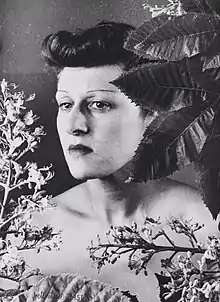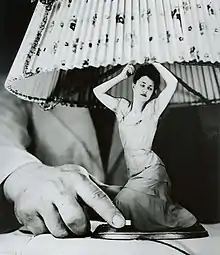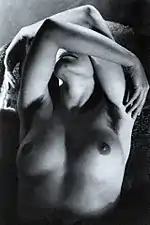Grete Stern
Grete Stern (9 May 1904 – 24 December 1999) was a German-Argentine photographer.[2] With her husband Horacio Coppola, she helped modernize the visual arts in Argentina, and presented the first exhibition of modern photographic art in Buenos Aires, in 1935.[3]
Grete Stern | |
|---|---|
 Stern in 1956 (Self-portrait) | |
| Born | Grete Stern 9 May 1904[1] |
| Died | 24 December 1999 (aged 95) |
| Nationality | German-Argentine |
| Occupation | Photography |
Early life
The daughter of Frida Hochberger and Louis Stern, Grete Stern was born on 9 May 1904 in Elberfeld, Germany.[3] She often visited family in England and attended primary school there. After reaching adulthood, from 1923 to 1925 she studied graphic arts at the Kunstgewerbeschule, Stuttgart, but after a short term working in the field she was inspired by the photography of Edward Weston and Paul Outerbridge to change her focus to photography. Relocating to Berlin, she took private lessons from Walter Peterhans.[2]:21
Career

In 1930 Stern and Ellen Rosenberg Auerbach founded ringl+pit, a critically acclaimed, prize-winning Berlin based photography and design studio. They used equipment purchased from Peterhans[3] and became well known for innovative work in advertising.[4] The name ringl+pit is from their childhood nicknames (Ringl for Grete, Pit for Ellen).[3]
Intermittently between April 1930 and March 1933, Stern continued her studies with Peterhans at the Bauhaus photography workshop in Dessau, where she met the Argentinian photographer Horacio Coppola. In 1933 the political climate of Nazi Germany led her to emigrate with her brother to England,[5] where Stern set up a new studio, soon to resume her collaboration there with Auerbach.[1][3]
Stern first traveled to Argentina in the company of her new husband, Horacio Coppola in 1935.[1] The newlyweds mounted an exhibition in Buenos Aires at Sur magazine, which according to the magazine, was the first modern photography exhibition in Argentina.[3] In 1958, she became a citizen of Argentina.

In 1948 Stern began working for Idilio, an illustrated women's magazine, targeted specifically at lower/lower-middle class women. In the late 1940s and early 1950s, Stern created Los Sueños as illustrations for the woman's magazine Idilio and its column "El psicoanálisis te ayudará" (Psychoanalysis Will Help You).[6] Readers were encouraged to submit their dreams to be analyzed by the 'experts' as an aid for its readers to find "self-knowledge and self-aid that would help them succeed in love, family and work".[7] Each week, one dream would be selected, analyzed in depth by the expert, Richard Rest, and then illustrated by Stern through photomontage. Stern created about 150 of these photomontages, of which only 46 survive in negatives.[8] Stern's photomontages are surreal interpretations of the readers' dreams that often subtly pushed back on the traditional values and concepts in Idilio magazine by inserting feminist critique of Argentinian gender roles and the psychoanalytic project in her images. The Idilio series has often been compared to Francisco Goya's Sueños drawings, a series of preliminary drawings for his later body of work, Los Caprichos; they have also been directly compared to Los Caprichos themselves.

Stern provided photographs for the magazine and served for a stint as a photography teacher in Resistencia at the National University of the Northeast in 1959 and continued to teach until 1985.[1]
Death
In 1985, she retired from photography, but lived another 14 years until 1999, dying in Buenos Aires on 24 December at the age of 95.[1]
Legacy
In 1995 documentarian Juan Mandelbaum made a documentary about Studio Ringl + Pit, which was reviewed in the New York Times In 2005 her work was the subject of an exhibition at New York's Museum of Modern Art called "From Bauhaus to Buenos Aires: Grete Stern and Horatio Coppola."
Collections
Stern's work is held in the following permanent collections:
- The Jewish Museum
- The Museum of Modern Art
- The Metropolitan Museum
- The J. Paul Getty Museum
References
- "Grete Stern. Biography". Gobierno de Buenos Aires. Archived from the original on 2011-06-29. Retrieved 2011-02-07.
- Stern, Grete; Coppola, Horacio; Marcoci, Roxana; Meister, Sarah Hermanson; Roberts, Jodi; Kaplan, Rachel (2015). From Bauhaus to Buenos Aires: Grete Stern and Horacio Coppola. New York: Museum of Modern Art. ISBN 9780870709616.
- "Grete Stern". Jewish Women's Archive. Mandelbaum, Juan, and Clara Sandler. Jewish Women: A Comprehensive Historical Encyclopedia. 1 March 2009. Retrieved February 7, 2011.
- James Crump. "Stern, Grete." Grove Art Online. Oxford Art Online. Oxford University Press. Updated and revised 27 September 1999. Retrieved October 3, 2015.
- O'Connor, John J. (1997-02-06). "Two Proto-Feminists Remember Weimar". The New York Times. ISSN 0362-4331. Retrieved 2018-03-11.
- Plotkin, Mariano Ben (April 1999). "Tell Me Your Dreams: Psychoanalysis and Popular Culture in Buenos Aires, 1930-1950". The Americas. 55 (4): 601–629. doi:10.2307/1008323. ISSN 0003-1615. JSTOR 1008323. PMID 19743564.
- "El psicoanálisis le ayudará". Idilio: 2. August 16, 1949.
- Marcoci, Roxana (2015). "Photographer Against the Grain: Through the Lens of Grete Stern" in From Bauhaus to Buenos Aires: Grete Stern and Horacio Coppola. New York: Museum of Modern Art. pp. 21–36. ISBN 9780870709616.
Further reading
- Thurman, Judith (December 19–26, 2016). "Grete Stern". Visionaries. The New Yorker. 92 (42): 100.
- Foster, David William. “Dreaming in Feminine: Grete Stern’s Photomontages and the Parody of Psychoanalysis” Ciberletras 10. 2004 http://www.lehman.cuny.edu/ciberletras/v10/foster.htm
- Lavin, Maud. “Ringl + Pit: The Representation of Women in German Advertising, 1929–33 in The Print Collector's Newsletter, Vol 16, No. 3 (July – August 1985), pp. 89–93
- Hopkinson, Amanda. "Grete Stern" obituary. The Guardian. January 18, 2000.
External links
| Wikimedia Commons has media related to Grete Stern. |